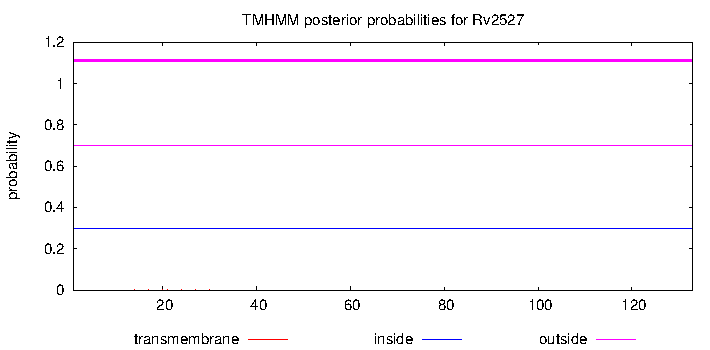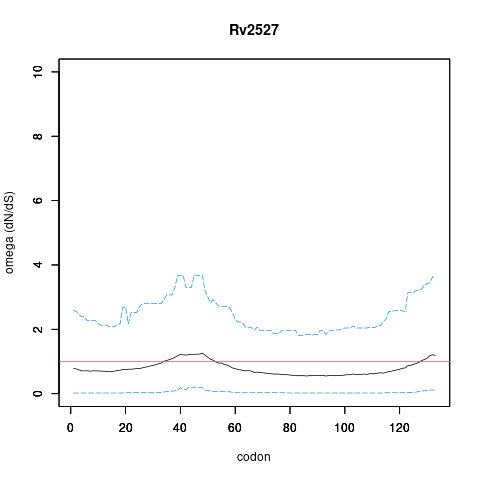| Property | Value | Creator | Evidence | PMID | Comment |
| Interaction | InhibitedBy Rv2526 | kandarpbioinfo | ISA | | Gene neighbourhood
authors,HR. Ramage,LE. Connolly,JS. Cox Comprehensive functional analysis of Mycobacterium tuberculosis toxin-antitoxin systems: implications for pathogenesis, stress responses, and evolution. PLoS Genet. 2009 |
| Citation | The PIN-domain toxin-antitoxin array in mycobacteria. authors,VL. Arcus,PB. Rainey,SJ. Turner Trends Microbiol. 2005 | soumisengupta | NAS | 15993073 | Co-expression (Functional linkage) |
| Interaction | Inhibition Rv2526 | soumisengupta | NAS | | Co-expression (Functional linkage)
authors,VL. Arcus,PB. Rainey,SJ. Turner The PIN-domain toxin-antitoxin array in mycobacteria. Trends Microbiol. 2005 |
| Citation | Killing activity and rescue function of genome-wide toxin-antitoxin loci of Mycobacterium tuberculosis. authors,A. Gupta FEMS Microbiol. Lett. 2009 | soumisengupta | NAS | 19016878 | Co-expression (Functional linkage) |
| Interaction | Inhibition Rv2526 | soumisengupta | NAS | | Co-expression (Functional linkage)
authors,A. Gupta Killing activity and rescue function of genome-wide toxin-antitoxin loci of Mycobacterium tuberculosis. FEMS Microbiol. Lett. 2009 |
| Interaction | InhibitedBy Rv2526 | kandarpbioinfo | ISA | | Gene neighbourhood
authors,VL. Arcus,PB. Rainey,SJ. Turner The PIN-domain toxin-antitoxin array in mycobacteria. Trends Microbiol. 2005 |
| Interaction | InhibitedBy Rv2526 | kandarpbioinfo | ISA | | Gene neighbourhood
authors,DP. Pandey,K. Gerdes Toxin-antitoxin loci are highly abundant in free-living but lost from host-associated prokaryotes. Nucleic Acids Res. 2005 |
| Citation | Comprehensive functional analysis of Mycobacterium tuberculosis toxin-antitoxin systems: implications for pathogenesis, stress responses, and evolution. authors,HR. Ramage,LE. Connolly,JS. Cox PLoS Genet. 2009 | jlew | | 20011113 | VapC homolog, PIN domain, Not toxic when expressed in Msmeg |
| Symbol | VapC17 | jlew | | | We report the heterologous toxicity of these TA loci in Escherichia coli and show that only a few of the M. tuberculosis-encoded toxins can inhibit E. coli growth and have a killing effect. This killing effect can be suppressed by coexpression of the cognate antitoxin.
authors,A. Gupta Killing activity and rescue function of genome-wide toxin-antitoxin loci of Mycobacterium tuberculosis. FEMS Microbiol. Lett. 2009 |
| Citation | Killing activity and rescue function of genome-wide toxin-antitoxin loci of Mycobacterium tuberculosis. authors,A. Gupta FEMS Microbiol. Lett. 2009 | jlew | | 19016878 | We report the heterologous toxicity of these TA loci in Escherichia coli and show that only a few of the M. tuberculosis-encoded toxins can inhibit E. coli growth and have a killing effect. This killing effect can be suppressed by coexpression of the cognate antitoxin. |
| Other | start:2851315 | rslayden | | | MTCY159.10c |
| Other | stop:2851716 | rslayden | | | MTCY159.10c |
| Other | strand:+ | rslayden | | | MTCY159.10c |
| Other | start:2851315 | rslayden | | | Rv2546 (137 aa), FASTA scores: opt: 206, E(): 1.4e-07, (38.0% identity in 100 aa overlap); O33299 |
| Other | stop:2851716 | rslayden | | | Rv2546 (137 aa), FASTA scores: opt: 206, E(): 1.4e-07, (38.0% identity in 100 aa overlap); O33299 |
| Other | strand:+ | rslayden | | | Rv2546 (137 aa), FASTA scores: opt: 206, E(): 1.4e-07, (38.0% identity in 100 aa overlap); O33299 |
| Other | start:2851315 | rslayden | | | MTV002.22c |
| Other | stop:2851716 | rslayden | | | MTV002.22c |
| Other | strand:+ | rslayden | | | MTV002.22c |
| Other | start:2851315 | rslayden | | | Rv2757c (138 aa), FASTA scores: opt: 201, E(): 3.1e-07, (35.7% identity in 126 aa overlap); and P96411 |
| Other | stop:2851716 | rslayden | | | Rv2757c (138 aa), FASTA scores: opt: 201, E(): 3.1e-07, (35.7% identity in 126 aa overlap); and P96411 |
| Other | strand:+ | rslayden | | | Rv2757c (138 aa), FASTA scores: opt: 201, E(): 3.1e-07, (35.7% identity in 126 aa overlap); and P96411 |
| Other | start:2851315 | rslayden | | | MTCY08D5.24c |
| Other | stop:2851716 | rslayden | | | MTCY08D5.24c |
| Other | strand:+ | rslayden | | | MTCY08D5.24c |
| Other | start:2851315 | rslayden | | | Rv0229c (226 aa), FASTA scores: opt: 153, E(): 0.0011, (32.8% identity in 128 aa overlap). |
| Other | stop:2851716 | rslayden | | | Rv0229c (226 aa), FASTA scores: opt: 153, E(): 0.0011, (32.8% identity in 128 aa overlap). |
| Other | strand:+ | rslayden | | | Rv0229c (226 aa), FASTA scores: opt: 153, E(): 0.0011, (32.8% identity in 128 aa overlap). |
| Other | start:2851315 | rslayden | | | Hypothetical protein, showing some similarity to hypothetical proteins from Mycobacterium tuberculosis e.g. P95007 |
| Other | stop:2851716 | rslayden | | | Hypothetical protein, showing some similarity to hypothetical proteins from Mycobacterium tuberculosis e.g. P95007 |
| Other | strand:+ | rslayden | | | Hypothetical protein, showing some similarity to hypothetical proteins from Mycobacterium tuberculosis e.g. P95007 |


